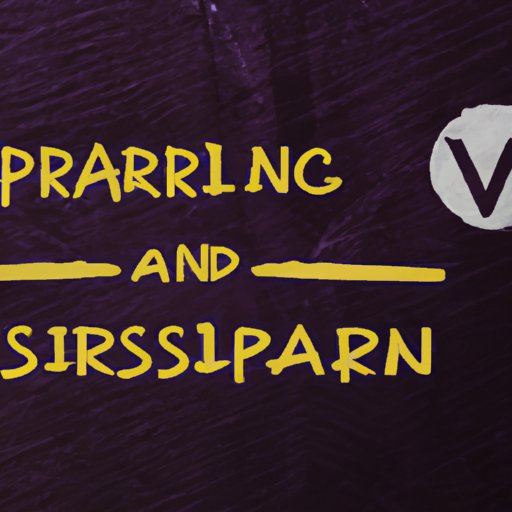I. Introduction
Personal branding has become increasingly important in today’s competitive landscape. It is no longer enough to have a strong skill set or an impressive resume. Developing a personal brand allows individuals to showcase their unique qualities, establish credibility, and differentiate themselves from the competition. In this article, we will explore practical tips for developing a personal brand that truly represents who you are and what you stand for.
II. Crafting Your Personal Narrative: Mastering the Art of Personal Branding
Having a unique and compelling personal story is crucial for developing a strong personal brand. Your personal narrative helps people connect with you on a deeper level and understand what sets you apart. Start by identifying key experiences or values that define you. These could be significant life events, personal challenges you’ve overcome, or core values that guide your decisions.
Once you have identified these defining experiences or values, you can shape your personal brand around them. For example, if you have a passion for sustainability, you could position yourself as an eco-conscious expert in your field. Your personal brand should reflect this passion and expertise through your online presence, networking efforts, and the content you create.
III. The Power of Consistency: Building a Strong Personal Brand Through Cohesion
Consistency is key when it comes to personal branding. Your messaging, visuals, and behavior should align across all channels to create a cohesive brand presence. This helps build trust and credibility with your audience.
To create a consistent brand presence, start by defining your personal brand guidelines. This includes your brand voice, tone, and values. Then, apply these guidelines to all aspects of your personal brand, such as your social media profiles, personal website, and networking events. Consistency should be evident in the way you communicate, the topics you discuss, and the visual elements you use.
For example, if you have defined your personal brand as innovative and forward-thinking, ensure that your online content reflects these qualities. Share articles or insights that align with this brand positioning, and use visuals that convey a sense of innovation and creativity.
IV. Leveraging the Digital Space: Personal Branding in the Digital Age
In today’s digital age, utilizing digital platforms is crucial for personal branding. While face-to-face interactions still play a vital role, digital platforms allow you to showcase your expertise, connect with a broader audience, and establish thought leadership.
Start by creating a strong LinkedIn profile that highlights your skills, accomplishments, and unique value proposition. Use LinkedIn to network with professionals in your industry and join relevant groups or communities. Consistently share valuable content to position yourself as a thought leader in your field.
In addition to LinkedIn, consider creating a personal blog or website where you can share your insights, expertise, and personal experiences. This serves as a central hub for your personal brand. Use social media platforms strategically to amplify your personal brand, engage with your audience, and share relevant content.

V. Networking with Purpose: Building Your Personal Brand through Strategic Connections
Networking plays a crucial role in personal branding. Building meaningful connections with industry professionals, mentors, and peers can open doors, provide support, and expand the reach of your personal brand.
When networking, focus on quality over quantity. Seek out individuals who align with your personal brand values and can add value to your professional journey. Attend industry events, join professional organizations, and participate in online communities related to your field of expertise.
In addition to connecting with others, be proactive in offering support and insights. Share your expertise, help others achieve their goals, and be generous with your time and resources. By being genuinely interested in others, you can build credibility and foster long-term connections that can benefit your personal brand.
VI. Authenticity Matters: Unleashing the Power of Your True Self in Personal Branding
Authenticity is a key element of personal branding. In a world where it’s easy to mimic others or create a persona, being true to yourself sets you apart. Embrace your unique qualities, express genuine opinions, and demonstrate integrity in all aspects of your personal brand.
To infuse authenticity into your personal brand, start by understanding your values and purpose. Ask yourself what matters most to you and how those values can be reflected in your personal brand. Be transparent about your journey, including both triumphs and challenges. This vulnerability can resonate with your audience and create a deeper connection.
Remember, being authentic doesn’t mean sharing every detail of your personal life. It means presenting your true self, staying true to your values, and being consistent in your actions and words.
VII. Beyond Words: The Role of Visuals and Aesthetics in Personal Branding
Visuals play a significant role in personal branding. The way you present yourself visually can impact how others perceive your personal brand. Invest in professional photography that captures your personality and aligns with your brand values.
In addition to personal branding materials like business cards and resumes, consider the power of visual storytelling. Use visuals to share your journey, showcase your expertise, and evoke emotions. Infographics, videos, and images can be powerful tools for conveying your personal brand message.
When creating visual content, ensure that it aligns with your personal brand guidelines. Use colors, fonts, and design elements that reflect your brand personality. Consistency is key, whether in the graphics you share on social media or the visuals you use on your personal website.
VIII. Conclusion
In today’s competitive landscape, developing a personal brand is crucial for standing out and achieving success. By crafting your personal narrative, being consistent across channels, leveraging digital platforms, networking strategically, embracing authenticity, and using visual elements intentionally, you can create a personal brand that authentically represents who you are and what you have to offer.
Implement the strategies discussed in this article and watch as your personal brand becomes a powerful asset in your professional journey.
(Note: Is this article not meeting your expectations? Do you have knowledge or insights to share? Unlock new opportunities and expand your reach by joining our authors team. Click Registration to join us and share your expertise with our readers.)
